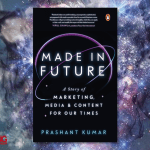By now Gen Z needs no introduction. They grew up with social media and tech and have never known a world without it. They’re also becoming the largest generation of consumers by 2020 and seem immune to any attempt to advertise to them. So how does that translate in the publishing world?
Through a three-part series, we examine the current state and future of print. From its unique relationship to Gen Z, its adoption by internet giants, to increase revenue, all the way to emerging markets, we take a deep dive into the power of print.
The U.S. newspaper industry shrunk by about $4.5 billion between 2011 and 2018, and respected publications such as The New York Times and The Washington Post have had extensive layoffs while others ceased their print version. But other publishers are refreshing their strategies for the print format and getting positive results.
While we live in a digital-first world, there is still a strong sense that print is valuable, especially to Gen Z. In 2018, The New York Times noted a rise in food-based, small-run magazines that focus on printed products. Notably, most of the magazines’ founders were 20 to 30 years old.
In fact, the last few years have brought in new, small and sophisticated titles produced on a shoestring by young editors, that seem to ignite the passion for print in their audiences. Consumer brands are also paying attention and racing to leverage the marketing opportunities associated with ink.

Printing.org- Gen Z and print
Print is, arguably, more meaningful than ever
In a world where just about anyone can be a ‘’publisher’’ and post fake news, audiences are starting to question the validity of their sources and Gen Z seems to trust print publications over other media to deliver credible information.
That’s what MNI Targeted Media Inc. discovered when it commissioned a study to gain insight into this generation, surveying students at major universities about their media consumption. Some 83% turn to newspapers for trusted information and content, and 34% turn to magazines.

Something Facebook probably had in mind when it launched its print quarterly Grow, available in select airports and railway stations. After facing strong criticism and scrutiny for mishandling user data, the company used its print medium to issue apologies to the public and to heavily publicise its ‘Fake news is not our friend’ campaign...
In fact, Gen Z is far from abandoning physical products. Another study from American University looked at over 300 college students in four countries, and found that 92% would rather do their coursework in print, as opposed to on tablets or computers.
This was substantiated in the UK by The 2019 Ofcom News Consumption Survey, which found that magazines are the UK’s most trusted source of news, across all generations.

In fact, generation Z is far from abandoning physical products. Another study from American University looked at over 300 college students in four countries, and found that 92% would rather do their coursework in print, as opposed to on tablets or computers.
This was substantiated in the UK by The 2019 Ofcom News Consumption Survey, which found that magazines are the UK’s most trusted source of news, across all generations.
Young consumers are very aware that magazine publishing doesn’t follow the same rules as social media and blogging, where speed trumps fact-checking, editing, and refining. All the necessary processes before something makes it into print.
Because generation Z grew up with technology, they seem to value print media as a way to disconnect from the digital noise they live with. In fact, and according to the study from MNI, 61% of Gen-Zers believe their peers would benefit from unplugging more. Even though they’re obsessed with their phones, the average Gen-Zer will still read magazines for about an hour every week according to Folio.
Terri White, Editor-in-Chief of the film magazine Empire from the Bauer Media Group says, “The digital space is a hectic, loud, cluttered landscape with bloggers, influencers, journalists, editors, writers, marketers all shouting into the void, their voices surfacing, or not, depending on SEO or algorithms.”
In contrast, she adds, “The intimacy is unrivaled” when readers hold print in their hands, “a visceral, powerful connection” is created. “In this increasingly digitized world, you cannot underestimate how much people just want to feel something real.”
This provides an even stronger case for investing in print, especially for advertisers targeting the younger generation, as both attention and interest seem to be of attendance.
The business case of printing: less is more
Several publishers who are successful in the print media are focusing on niche audiences who are willing to pay more for a higher grade product. And decreasing the publishing frequency helps in that regard.
Take the Harvard Business Review. Two years ago, the publication cut down its print frequency from 10 to six issues a year. Amidst declining revenues in print, HBR’s move led to a 10% increase in subscribers.
Adi Ignatius, Editor-in-Chief of the Harvard Business Review, calls the print version of HBR their “crown jewel” and attributes the growth in subscribers to a combination of smart positioning, creative new digital benefits, and heavier investment in the six print issues.
Less is more for smaller independent publications too. The titles are often led by young editors falling into the 20-30 age range and frustrated with the industry overlooking important topics they’re passionate about. Staff tend to be tiny (often one or two people), as do circulations (150 to 15,000). But what these titles lack in size, they make up for in content and reach.
Despite all the challenges, some titles persist and grow, capturing not only younger audiences, but legacy publications’ attention as well.
In 2018, The Guardian worked with gal-dem, a magazine committed to sharing perspectives from women and non-binary people of colour, issuing a gal-dem’s takeover of Weekend magazine. The feedback was overwhelmingly positive and sales even spiked.
This serves as a reminder that traditional publications can draw lessons from independent prints. In the end, they are made by and for the younger generation, thus having insider knowledge of how to capture that audience.


gal-dem weekend takeover, The Guardian
The Takeaway
Print isn’t a replacement for generation Z’s digital lives but serves as an addition. Both millennials and Gen-Z are turning to magazines because they offer a different experience than what they’re used to.
Many in fact refer to Gen-Z as the ‘’omnichannel generation’’, stressing the fact that publishers should consider using a combination of print and digital marketing approaches to successfully monetize this audience.
Consumer brands show us that with Gen-Z, real-life interactions and integration of tech with brick and-mortar are smart moves. The same applies to publishing, where media companies can use print to enhance their connection to their audience, ultimately speaking to their desire of making sophisticated choices about identity, purpose, and values.
source: http://www.reuterscommunity.com
MARKETING Magazine is not responsible for the content of external sites.












